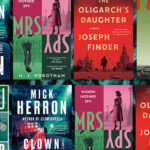
On Transforming Oral History Into Historical Fiction
Aanchal Malhotra Tells the Story of Indian Partition
The history of all four of my grandparents can be traced back to what is now Pakistan. But stories of their migrations to India due to the Partition of British India in August 1947, or their rehabilitation in refugee camps thereafter, were never told. Like many of their generation, they practiced resolute silence, either by choice or lack thereof, where I barely remember even hearing the word growing up. For the most part, the politics of partitioning a subcontinent and the colossal data of migration, displacement and death have largely overshadowed the individuality of the witness, their particular stories, their extraordinary losses.
In 2013, a conversation with my maternal granduncle drew me into this largely silenced family history, as well as a new career. At the time, I was back in New Delhi on a sabbatical back from graduate school in Montréal, where I was studying to be a traditional printmaker. The conversation, propelled by two objects of age—a vessel and a yardstick—transported us across the manmade border between India and Pakistan, and back in time to the moment of Partition. The objects had been carried by his family from Lahore to Amritsar, and further to Delhi.
While caressing their metallic surfaces, he offered me his memories of a childhood in Lahore, the lanes he bicycled on or the clothing shop his grandfather owned in Anarkali Bazaar, and confessed that sometimes in his dreams, he could return to Lahore in a way that the realities and geopolitics of the present world may never allow him to. That birthplace, Lahore—now in Pakistan, the country across the border—had transformed into dreamspace.
Driven by our conversation, I embarked on what would become a decade-long research project across the subcontinent and its diaspora, interviewing multiple generations of Partition-impacted families, descending into an aged trauma that had found ways to persist even decades later. This work culminated in the writing of two books of oral history, Remnants of Partition (2019), published in South Asia as Remnants of a Separation (2017), and In the Language of Remembering (2022), which together looked at the human history and long-term, multi-generational, cross-border legacy of Partition.
To listen to people’s stories is a privilege, but it can very quickly consume your life.
But it was even before the publication of the first book, that I’d begun to think about a novel that involved Partition. By then, I’d spent a few intense years recording interviews, a process not without its difficulties, and was gradually transforming from visual artist to oral historian. Soon the studio was left behind, for despite being formally untrained in the discipline, I embraced oral history, recording, transcribing, translating, interpreting as diverse an archive of testimonies as I could. I heard stories of unthinkable violence, but alongside were also extraordinary stories of courage, sacrifice, resilience, hope, love, separation, reunion, rehabilitation, and longing.
Few historical novelists have the skills of a professional historian, or the access to primary material and archive. But for an event like Partition, where traditional means of narration have failed to do justice to the depth of historical trauma, oral testimony, reliant of human memory—with all its complexities, shortcomings, even contradictions—has proved to be the richest archive.
Years of recording other people’s lives had made me an empathetic writer, but I never thought myself an imaginative one. How did one begin a novel? Why was I drawn to the idea of fiction? What were the limitations of non-fiction, if any, that I felt could be fulfilled by fiction? What happens to language when it moves from non-fiction to fiction? These were the questions I was asking as I continued to write non-fiction, but began drafting a skeleton of what would become The Book of Everlasting Things.
I wish there was another way to say this, but the sheer number of interviews, the wide-ranging experiences of trauma and accumulative sadness of others had also begun to weigh me down. There was a density of pain in these memories—many of which were being uttered for the first time since 1947—which presented me the responsibility to do justice to each telling. To listen to people’s stories is a privilege, but it can very quickly consume your life. During these times, the novel became my respite.
There was something liberating about the form of fiction—I could construct and reconstruct the stories of my characters, whereas in non-fiction, I could only transcribe and interpret them, never alter the testimony I was receiving. I read somewhere that Hilary Mantel once said she was trying to make “fiction flexible so that it bends around the facts as we have them”. Perhaps I was attempting to do the opposite. A lot of my transition from historian to novelist was allowing myself to create space within history, to make it malleable enough and create an opening for it to absorb fictional characters, and in turn, make them real enough to be considered a natural part of that history.
The real problem, though, was whether or not I knew how to write a novel. I was not interested in making up a world, and frankly, neither was I so inventive. Though the time period of my novel was the same as it had been in non-fiction, it was the smallest things that served as roadblocks, that I’d taken for granted during my interviews—the color of the walls, the shape of the room, the vastness of a field and the crops that grew in it, the light falling on my interviewee, their clothes, what objects they held dear, what language they spoke and whether they’d move between various languages, the stones in the courtyard, the patterns on their carpets or the kind of ceiling fan in their homes.
I could make up the thoughts and dreams and inner desires of my characters, their personal politics and even the larger social landscape they occupied, but the details of how a scene was to be constructed, which had always been available to me or furnished through interviews, were absent. And when it came to inserting those details through research, how much was too much? How accurate did every day, every incident, every newspaper headline, every radio broadcast need to be?
I don’t think I could have written this novel without the years I spent writing oral history.
Moreover, the structure of a non-fiction manuscript—the bones at least—don’t really change so much from start to finish, particularly when the primary source material is oral testimony. I may move parts around, but the core of the book will remain determined by the interviews I’ve been able to gather during field research. With fiction, however, it was difficult to predict if what I started with as an idea would even end up on the pages of my final novel.
Through the processes of drafting, writing, editing, thinking, dreaming, discussing, doubting, rewriting, characters demanded space, gained voice, acquired agency, contradicted their own best interests—albeit, all through my pen—in a way that was a rare occurrence in the kind of narrative non-fiction I wrote.
But ultimately, I don’t think I could have written this novel without the years I spent writing oral history. When I read the manuscript of The Book of Everlasting Things, I try to make sense of how exactly the pieces all fit together—for instance, I remember which dialogue about falling in love was said when and where by which interviewee in real life, or how scenes of student protests against Partition were narrated to me by someone who had been there, or how the home of my protagonists looked like the home of my grandmother which burned down in the fire of 1947. This book could have only been written by immersing myself in the subject of Partition for as deeply and intimately as I have.
My preoccupation as a writer, in whatever genre, has largely been of memory—the recording and preserving of it. It was silence that carved me into an oral historian, and a sensorial curiosity that made me a novelist. But ultimately, I feel that it’s not so different writing about my fictional characters than it is writing about any of my interviewees. The care and investment into each of these is the same. Neither my research methodology nor my style of writing are that different. What is different is the manner of thinking—a change in the intention of why a story must be written. But essentially, both my forms of writing feel like forms of retrieval. A desire to situate the individual and personal within the framework of the collective or political; wanting to understand, introspect and experience history from within.
__________________________________

The Book of Everlasting Things by Aanchal Malhotra is available from Flatiron Books, an imprint of Macmillan.
Aanchal Malhotra
Aanchal Malhotra is a writer and oral historian from New Delhi, India. A co-founder of the Museum of Material Memory, Malhotra has written two nonfiction books on the human history and generational impact of the 1947 Partition, titled Remnants of Partition and In the Language of Remembering. The Book of Everlasting Things is her debut novel.



















